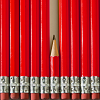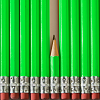Or search by topic
Number and algebra
Geometry and measure
Probability and statistics
Working mathematically
Advanced mathematics
For younger learners
Exploring and Noticing Structure - Short Problems
This is part of our collection of Short Problems.
You may also be interested in our longer problems on Exploring and Noticing Structure.

Suit Sequence



A pattern repeats every six symbols. What are the 100th and 101st symbols?
Royal Arm Wrestling



How many arm-wrestles will there be in the royal arm wrestling championship?

Knockdown



Weekly Problem 51 - 2016
Pegs numbered 1 to 50 are placed in a row. Alternate pegs are knocked down, and this process is repeated. What is the number of the last peg to be knocked down?
Take a Leaf



An examination paper is made from five pieces of paper. What is the sum of the other page numbers that appear on the same sheet as page 5?

Out of Sync



Albert Einstein could see two clocks which were out of sync. For what fraction of the day did they show the same time?

Halloween Day



One year there were exactly four Tuesdays and four Fridays in October. On what day of the week was Halloween.

How Many Rectangles?



By drawing 5 horizontal and four vertical lines, one can form 12 rectangles. What is the greatest number of rectangles that can be formed by drawing 15 lines?

Almost Constant Digits



How many 10-digit numbers containing only 1s, 2s and 3s can you write?

Too Close to Call



Weekly Problem 24 - 2012
Can you put these very close fractions into order?

Newspaper Sheets



From only the page numbers on one sheet of newspaper, can you work out how many sheets there are altogether?

Collatz-ish



A sequence is generated using these rules. For which values of n is the nth term equal to n?

12345



Repeat a pattern of numbers to form a larger number. Can you find the sum of all the digits?

Back in Time



How many times a day does a 24 hour digital clock look the same when reflected in a horizontal line?

